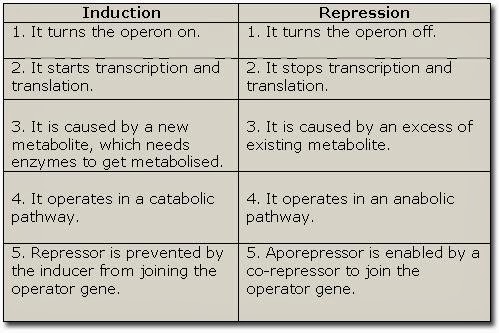Operons: Inducible Systems vs. Repressible
Inducible:
A very common example for an inducible operon system, is the lac, or lactose operon system. (Shown below) I will give explanations alongside the picture in blue for a clearer understanding of what's happening.
The lac operon is an inducible operon that utilizes lactose as an energy source and is activated when glucose is low and lactose is present.
When there is no lactose in a system, the repressor stops the operator. The repressor is just what it sounds like. It doesn't allow the operator, which operates the system, to produce the enzyme and, instead, represses it. This is because producing an enzyme that can digest the lactose takes a lot of energy. So if there is no lactose in the system, it would be a total waste of energy to produce enzymes that could digest it. So, it is blocked and now the RNA polymerase cannot read it and code for the lactase.
However, when there is lactose present, the lactose acts as a key to unlock the repressor. Once it is "unlocked" the RNA polymerase comes in and reads the entire gene.
So the best analogy to explain the inducible system is a gatekeeper that protects something, in this case, a gene. The gatekeeper in the inducible system is the repressor. It chooses when to let people, RNA polymerase pass. Lactose acts as the key or the consent for the gatekeeper. When lactose gives the okay and says it needs some lactase to help digest it, the gatekeeping repressor gives the okay and the RNA Polymerase goes through and does what it needs to in order to make the enzyme.
Repressible:
The tryptophan (trp) operon of E. coli is an example of repressible operon.
These genes transcribe mRNAs, which are translated by ribosomes and tRNAs into the polypeptides. They later function as enzymes.
The promoter gene is adjacent to the operator gene. This is where the RNA polymerases enzymes bind. When the operator is in its "turned on" state, the enzyme, RNA polymerase, can move over the operator gene to the specific structural gene, and then the transcription can begin.
Basically, the repressible system works in the opposite way of the inducible. Here is a quick guide explaining some important differences between the two:



No comments:
Post a Comment